What is Imitrex Injection?
Imitrex injection is a prescription medicine used to treat acute migraine headaches with or without aura and acute cluster headaches in adults who have been diagnosed with migraine or cluster headaches.
Imitrex injection is not used to treat other types of headaches such as hemiplegic (that make you unable to move on one side of your body) or basilar (rare form of migraine with aura) migraines.
Imitrex injection is not used to prevent or decrease the number of migraine or cluster headaches you have.
It is not known if Imitrex injection is safe and effective in children under 18 years of age.
What is the most important information I should know about Imitrex Injection?
Imitrex Injection can cause serious side effects, including:
Heart attack and other heart problems. Heart problems may lead to death.
Stop taking Imitrex Injection and get emergency medical help right away if you have any of the following symptoms of a heart attack:
- discomfort in the center of your chest that lasts for more than a few minutes, or that goes away and comes back
- severe tightness, pain, pressure, or heaviness in your chest, throat, neck, or jaw
- pain or discomfort in your arms, back, neck, jaw, or stomach
- shortness of breath with or without chest discomfort
- breaking out in a cold sweat
- nausea or vomiting
- feeling lightheaded
Imitrex Injection is not for people with risk factors for heart disease unless a heart exam is done and shows no problem. You have a higher risk for heart disease if you:
- have high blood pressure
- have high cholesterol levels
- smoke
- are overweight
- have diabetes
- have a family history of heart disease
Who should not use Imitrex Injection?
Do not use Imitrex Injection if you have:
an allergy to sumatriptan or any of the ingredients in Imitrex Injection. See the end of this guide for a complete list of ingredients in Imitrex Injection.
- heart problems or a history of heart problems.
- narrowing of blood vessels to your legs, arms, stomach, or kidneys (peripheral vascular disease).
- uncontrolled high blood pressure.
- severe liver problems.
- hemiplegic migraines or basilar migraines. If you are not sure if you have these types of migraines, ask your healthcare provider.
- had a stroke, transient ischemic attacks (TIAs), or problems with your blood circulation.
- taken any of the following medicines in the last 24 hours:
- almotriptan (Axert)
- frovatriptan (Frova)
- rizatriptan (Maxalt, Maxalt-MLT)
- ergotamines (Cafergot, Ergomar, Migergot)
- eletriptan (Relpax)
- naratriptan (Amerge)
- sumatriptan and naproxen (Treximet)
- dihydroergotamine (D.H.E. 45, Migranal)
Ask your healthcare provider if you are not sure if your medicine is listed above.
What should I tell my healthcare provider before using Imitrex Injection?
Before taking Imitrex Injection, tell your healthcare provider about all of your medical conditions, including if you:
- have high blood pressure
- have high cholesterol
- have diabetes
- smoke
- are overweight
- have heart problems or family history of heart problems or stroke
- have kidney problems
- have liver problems
- are allergic to latex
- have had epilepsy or seizures
- are not using effective birth control
- are pregnant or plan to become pregnant. It is not known if Imitrex Injection can harm your unborn baby.
- are breastfeeding or plan to breastfeed. Imitrex Injection passes into your breast milk. It is not known if this can harm your baby. Talk with your healthcare provider about the best way to feed your baby if you take Imitrex Injection.
Tell your healthcare provider about all the medicines you take, including prescription and over-the-counter medicines, vitamins, and herbal supplements.
Imitrex Injection and certain other medicines can affect each other, causing serious side effects.
Especially tell your healthcare provider if you take antidepressant medicines called:
- selective serotonin reuptake inhibitors (SSRIs)
- serotonin norepinephrine reuptake inhibitors (SNRIs)
- tricyclic antidepressants (TCAs)
- monoamine oxidase inhibitors (MAOIs)
Ask your healthcare provider or pharmacist for a list of these medicines if you are not sure.
Know the medicines you take. Keep a list of them to show your healthcare provider or pharmacist when you get a new medicine.
How should I use Imitrex Injection?
- Certain people should take their first dose of Imitrex Injection in their healthcare provider’s office or in another medical setting. Ask your healthcare provider if you should take your first dose in a medical setting.
- Use Imitrex Injection exactly as your healthcare provider tells you to use it.
- Your healthcare provider may change your dose. Do not change your dose without first talking with your healthcare provider.
- For adults, the usual dose is a single injection given just below the skin.
- You should give an injection as soon as the symptoms of your headache start, but it may be given at any time during a migraine or cluster headache attack.
- If you did not get any relief after the first injection, do not give a second injection without first talking with your healthcare provider.
- If your headache comes back or you only get some relief after your first injection, you can take a second injection 1 hour after the first injection, but not sooner.
- Do not take more than 12 mg in a 24‑hour period.
- If you use too much Imitrex Injection, call your healthcare provider or go to the nearest hospital emergency room right away.
- You should write down when you have headaches and when you take Imitrex Injection so you can talk with your healthcare provider about how Imitrex Injection is working for you.
What should I avoid while using Imitrex Injection?
Imitrex Injection can cause dizziness, weakness, or drowsiness. If you have these symptoms, do not drive a car, use machinery, or do anything where you need to be alert.
What are the possible side effects of Imitrex Injection?
Imitrex Injection may cause serious side effects. See “What is the most important information I should know about Imitrex Injection?”
These serious side effects include:
- changes in color or sensation in your fingers and toes (Raynaud’s syndrome)
- stomach and intestinal problems (gastrointestinal and colonic ischemic events). Symptoms of gastrointestinal and colonic ischemic events include:
- sudden or severe stomach pain
- stomach pain after meals
- weight loss
- fever
- nausea or vomiting
- constipation or diarrhea
- bloody diarrhea
- problems with blood circulation to your legs and feet (peripheral vascular ischemia). Symptoms of peripheral vascular ischemia include:
- cramping and pain in your legs or hips
- feeling of heaviness or tightness in your leg muscles
- burning or aching pain in your feet or toes while resting
- numbness, tingling, or weakness in your legs
- cold feeling or color changes in 1 or both legs or feet
- medication overuse headaches. Some people who use too many Imitrex injections may have worse headaches (medication overuse headache). If your headaches get worse, your healthcare provider may decide to stop your treatment with Imitrex Injection.
- serotonin syndrome. Serotonin syndrome is a rare but serious problem that can happen in people using Imitrex Injection, especially if Imitrex Injection is used with anti‑depressant medicines called SSRIs or SNRIs.
Call your healthcare provider right away if you have any of the following symptoms of serotonin syndrome:- mental changes such as seeing things that are not there (hallucinations), agitation, or coma
- fast heartbeat
- changes in blood pressure
- high body temperature
- tight muscles
- trouble walking
- hives (itchy bumps); swelling of your tongue, mouth or throat.
- seizures. Seizures have happened in people taking Imitrex Injection who have never had seizures before. Talk with your healthcare provider about your chance of having seizures while you take Imitrex Injection.
The most common side effects of Imitrex Injection include:
- pain or redness at your injection site
- tingling or numbness in your fingers or toes
- dizziness
- warm, hot, burning feeling to your face (flushing)
- discomfort or stiffness in your neck
- feeling weak, drowsy, or tired
Tell your healthcare provider if you have any side effect that bothers you or that does not go away.
These are not all the possible side effects of Imitrex Injection. Call your doctor for medical advice about side effects. You may report side effects to FDA at 1-800-FDA-1088.
General information about the safe and effective use of Imitrex Injection
Medicines are sometimes prescribed for purposes other than those listed in Patient Information leaflets. Do not use Imitrex Injection for a condition for which it was not prescribed. Do not give Imitrex Injection to other people, even if they have the same symptoms you have. It may harm them.
This Patient Information leaflet summarizes the most important information about Imitrex Injection. If you would like more information, talk with your healthcare provider. You can ask your healthcare provider or pharmacist for information about Imitrex Injection that is written for healthcare professionals.
For more information, go to www.gsk.com or call 1-888-825-5249.
How should I store Imitrex Injection?
- Store Imitrex Injection between 36°F to 86°F (2°C to 30°C).
- Store your medicine away from light.
- Keep your medicine in the packaging or carrying case provided with it.
Keep Imitrex Injection and all medicines out of the reach of children.
What are the ingredients in Imitrex Injection?
Active ingredient: sumatriptan succinate
Inactive ingredients: sodium chloride, water for injection
Instructions for Use
|
Imitrex (IM-i-trex) STATdose System (sumatriptan succinate) Injection |
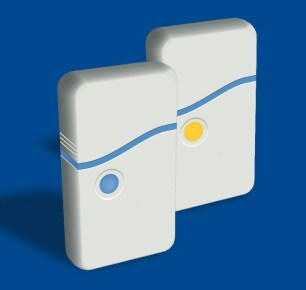 |
Read this Instructions for Use before you start to use the Imitrex STATdose System. There may be new information. This information does not take the place of talking with your healthcare provider about your medical condition or treatment. You and your healthcare provider should talk about Imitrex Injection when you start taking it and at regular checkups.
Keep the Imitrex STATdose System out of the reach of children.
Before you use the Imitrex STATdose System
When you first open the Imitrex STATdose System box, the Cartridge Pack and the Imitrex STATdose Pen are already in the Carrying Case for your convenience.
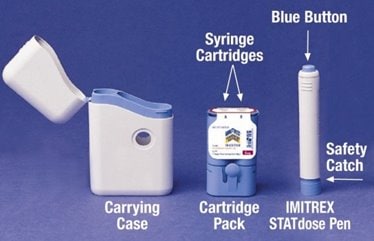
The grey and blue Carrying Case is used for storing the unloaded Pen and the Cartridge Pack when they are not being used.
- The Cartridge Pack holds 2 individually sealed Syringe Cartridges. Each Syringe Cartridge holds 1 dose of Imitrex (sumatriptan succinate) Injection.
- The Cartridge Pack for the 4-mg strength of this medicine is yellow.
- The Cartridge Pack for the 6-mg strength is blue (as shown).
- Refill Cartridge Packs are available.
Important Things to Know About Your Imitrex STATdose System
- The needle shield of the prefilled syringe contains dry natural rubber, which is made from latex. This is a part you cannot usually see, but it could still cause an allergic reaction. Tell your healthcare provider if you are allergic to latex.
- Before you use Imitrex STATdose System your healthcare provider should show you or your caregiver how to give an injection the right way.
- The Pen is used to automatically inject 1 dose of medicine from a Syringe Cartridge.
- Before you load a Syringe Cartridge, always check to make sure that the white Priming Rod is not sticking out from the end of the Pen (as shown below in Figure B). If it is sticking out, you will lose that dose.
- Do not touch the Blue Button until you have pressed the Pen firmly against your skin to give a dose.
- The Pen will only work when the Safety Catch is released. To release the Safety Catch, you must press the Pen firmly against your skin until the grey part of the barrel slides against the blue part and it cannot be pressed any further. The grey part of the barrel must stay in contact with the blue part while you inject your medicine.
- When you inject the dose, make sure the Pen stays in contact with your skin during the injection. It is important to hold the Pen against the skin for at least 5 seconds.
- After each use the Pen must be put back into the Carrying Case to reset the white Priming Rod before the next use.
How to load the Imitrex STATdose Pen
Do not load the Pen until you are ready to give yourself an injection.
Do not touch the Blue Button on top of the Pen (see Figure A) while you are loading the Pen.
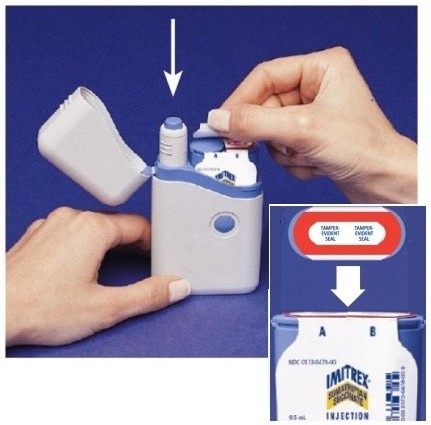
Figure A
1. Open the lid of the Carrying Case.
- Your new Carrying Case will come with 2 Syringe Cartridges already inside.
- The tamper-evident seals over the 2 Syringe Cartridges are labeled “A” and “B” (see Figure A).
- Always use the Syringe Cartridge marked “A” before the one marked “B” to help you keep track of your doses. Do not use if either seal is broken or missing when you first open the Carrying Case.
- Check the expiration date on the Cartridge Pack. Do not use if expired.
2. Tear off one of the tamper-evident seals (see Figure A). Throw away the seal. Open the lid over the Syringe Cartridge.
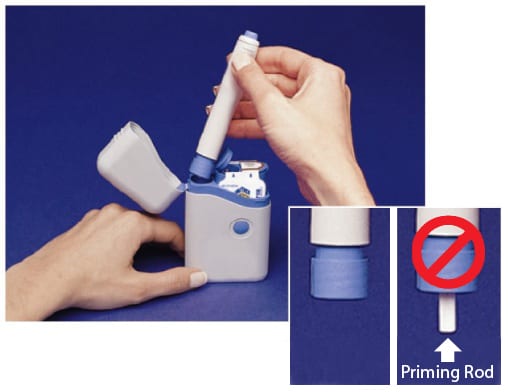
Figure B
3. Hold the Pen by the ridges at the top. Take the Pen out of the Carrying Case (see Figure B).
Check to make sure the white Priming Rod is not sticking out from the lower end of the Pen (see Figure B) . If it is sticking out, put the Pen back into the Carrying Case and press down firmly until you feel it click. Take the Pen out of the Carrying Case.
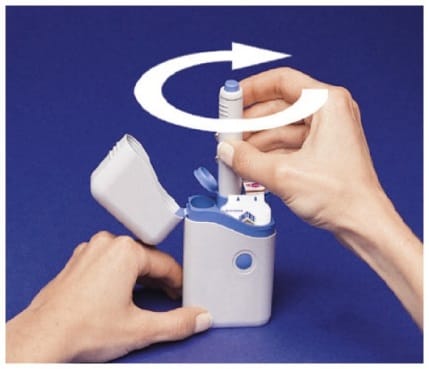
Figure C
4. Put the Pen in the open Cartridge Pack. Turn it to the right (clockwise) until it will not turn any more (about half a turn) (see Figure C).
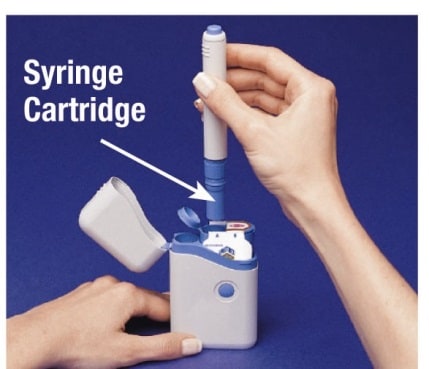
Figure D
5. Hold the loaded Pen by the ridges and pull it straight out (see Figure D). You may need to pull hard on the Pen, but this is normal. Do not press the Blue Button yet.
The Pen is now ready to use. Do not put the loaded Pen back into the Carrying Case because that will damage the needle.
How to use the Imitrex STATdose Pen to take your medicine

Figure E
6. Choose and Prepare the Injection Site.
- Before injecting your medicine, choose one area with a fatty tissue layer (see Figure E or Figure F).
- Ask your healthcare provider if you have a question about where to inject your medicine.
- To prepare the area of skin where Imitrex is to be injected, wipe the injection site with an alcohol swab.
- Do not touch this area again before giving the injection. Be sure to change the injection site with each dose.
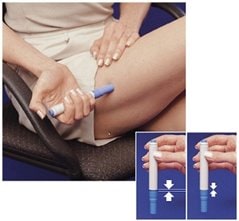
Figure F
7. Inject with the Imitrex STATdose Pen.
- Without pushing the Blue Button, press the loaded Pen firmly against the skin so that the grey part of the barrel slides against the blue part until it cannot be pressed any further. Make sure the grey part of the barrel stays in contact with the blue part that holds the Syringe Cartridge. This releases the Safety Catch that keeps the Pen from giving your injection by mistake or until you are ready (see Figure F).
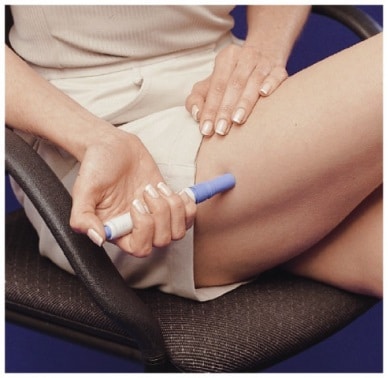
Figure G
- With the Pen still pressed firmly against the skin, push the Blue Button (see Figure G).
- Hold the Pen still for at least 5 seconds against the skin. If the Pen is taken away from your skin too soon, you will not receive all the medicine or it may leak out of the Pen.
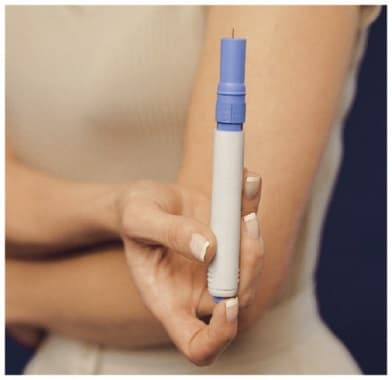
Figure H
8. Remove STATdose Pen from your skin.
- After 5 seconds, carefully take the Pen away from your skin. The needle will be showing (see Figure H).
- Do not touch the needle.
How to unload the Imitrex STATdose Pen after taking your medicine
Right after you complete your injection with the Pen, you need to return the used Syringe Cartridge to the Cartridge Pack.
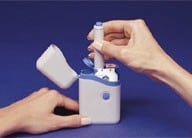
Figure I
9. Push the Pen down into the empty side of the Cartridge Pack as far as it will go (see Figure I).
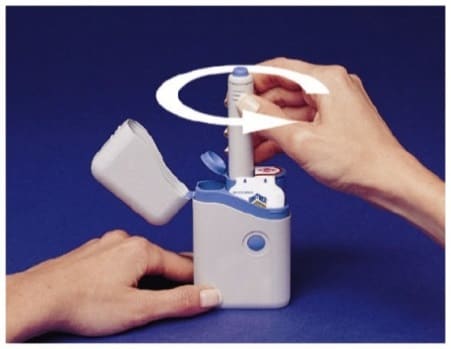
Figure J
10. Turn the Pen to the left (counterclockwise) about half a turn until it is released from the Syringe Cartridge (see Figure J).
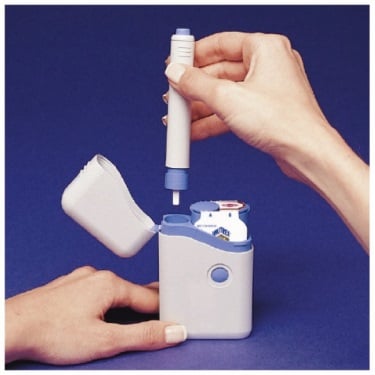
Figure K
11. Pull the empty Pen out of the Cartridge Pack.
- Because the Pen has now been used, the white Priming Rod will stick out from the lower end of the Pen (see Figure K).
12. Close the Cartridge Pack lid over the used Syringe Cartridge.
- When the used Syringe Cartridges are inserted correctly, the Cartridge Pack is a disposable, protective case to help you avoid needle sticks.
13. Put the Pen back into the Carrying Case and press it down firmly until you feel it click.
- This step is important to reset the Pen so that the white Priming Rod does not stick out and to get the Pen ready for the next use.
14. Close the Carrying Case lid.
- If the lid will not close, push the Pen down until you feel it click. Then close the lid.
How to take out a used Cartridge Pack
After both Syringe Cartridges have been used, take the Cartridge Pack out of the Carrying Case. Do not reuse or recycle a Syringe Cartridge.
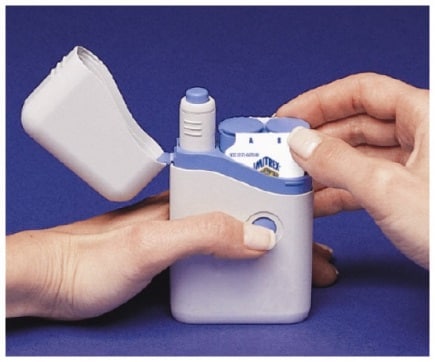
Figure L
15. Open the Carrying Case lid.
16. Hold the Carrying Case with one hand and press the 2 buttons on either side of the Carrying Case (see Figure L).
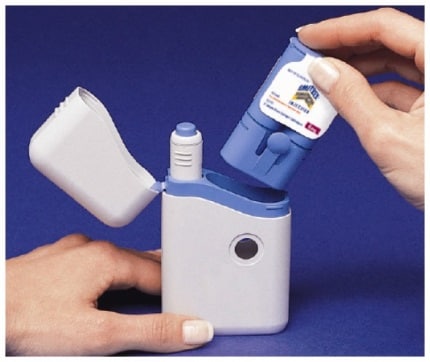
Figure M
17. Gently pull out the Cartridge Pack with the other hand (see Figure M).
18. Throw away the Cartridge Pack or dispose of it as instructed by your healthcare provider. See “How to Dispose of your used Syringe Cartridge Pack” below.
There may be special state and local laws for disposing of used needles and syringes.
How to insert a new Cartridge Pack
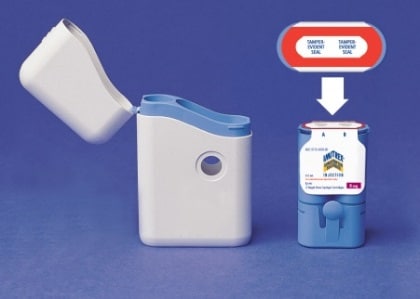
Figure N
19. Take the new Cartridge Pack out of its box. Do not take off the tamper‑evident seals (see Figure N).
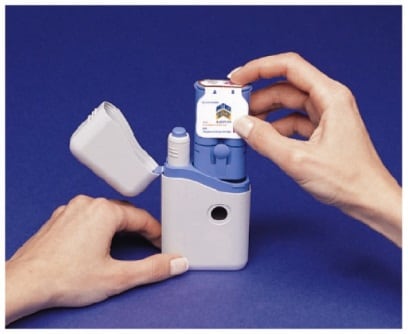
Figure O
20. Put the Cartridge Pack in the Carrying Case. Slide it down smoothly (see Figure O).
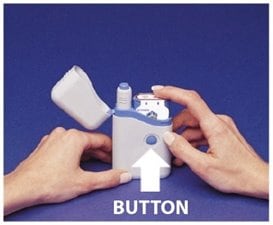
Figure P
21. The Cartridge Pack will click into place when the 2 buttons show through the holes in the Carrying Case (see Figure P). Close the lid.
How to dispose of your used Syringe Cartridge Pack
Put your used syringe cartridge pack in a FDA-cleared sharps disposal container right away after use (see Figure Q). Do not throw away (dispose of) loose needles and syringes in your household trash.

Figure Q
- If you do not have a FDA-cleared sharps disposal container, you may use a household container that is:
- made of a heavy-duty plastic,
- can be closed with a tight-fitting, puncture-resistant lid, without sharps being able to come out, upright and stable during use,
- leak-resistant, and
- properly labeled to warn of hazardous waste inside the container.
- When your sharps disposal container is almost full, you will need to follow your community guidelines for the right way to dispose of your sharps disposal container. There may be state or local laws about how you should throw away used needles and cartridges. For more information about safe sharps disposal, and for specific information about sharps disposal in the state that you live in, go to the FDA’s website at: http://www.fda.gov/safesharpsdisposal.
- Do not dispose of your used sharps disposal container in your household trash unless your community guidelines permit this. Do not recycle your used sharps disposal container.




